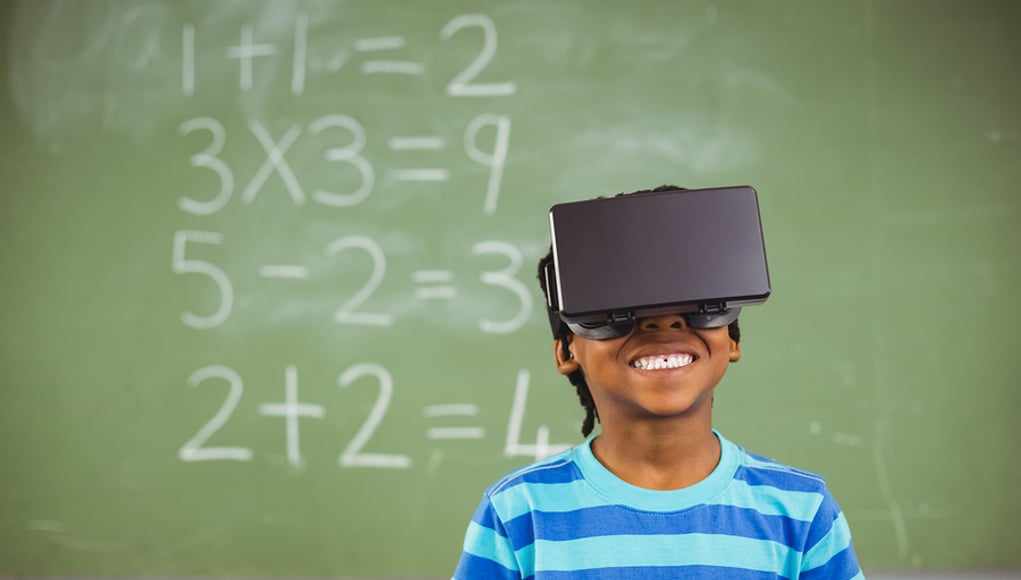How Virtual Reality and Embodied Learning Could Disrupt Education

Immersive VR in a headset is not meant to usurp traditional education, nor to replace face-to-face teacher interactions. VR hype is rampant, but as a learning scientist I discourage the hysteria, and I do not support the claim that VR will be a panacea for every disengaged learner. Rather, I encourage designers of educational VR content to reserve the immersive headset experience for purposes best served by 3D and immersion. Some of these purposes are highlighted in a talk by Jeremy Bailenson. VR is best used to get around the:
- Impossible – You can’t change skin color, but if your avatar has a different skin color or gender when you look down, this will affect your implicit biases for weeks to come (see Mel Slater’s work); you can’t slo-mo view a photon going directly into your eye in the classroom, but in VR you can (TimeFireVR).
- Expensive – You (probably) can’t fly your whole school to Machu Picchu.
- Dangerous – You wouldn’t want to train emergency landings by crashing real airplanes, but you would want to have complete control when leveling up phobia exposure therapy and re-enactments of PTSD-inducing events.
Additionally, VR should be used to make the unseen be seen. Good ol’ 2D simulations have been doing that for a while, but there is something indescribably visceral about sensations in VR. You experience what researchers call “presence.” It is the difference between peering at fish in the shallow waters versus scuba diving amongst them. With the addition of hand controls, education designers can now truly push the boundaries of embodied education and using gestures to learn.
What is embodied education?
The concept is based on constructivism (the traditional idea that students learn via experiences and interactions with the world) and the newer idea of embodiment (that the body and cognition are intertwined). Learning something means that you have created a strong enough memory trace to retain it. Adding more modalities, like touch and audio, strengthens the memory trace or signal. Adding VR-induced presence and the sensorimotor signals from the hand controls should further strengthen the memory trace. When learners create their own experiences via gesture, that physical movement can offload cognition and allow the other modalities to increase learning and strengthen the memory trace further. We know that knowledge can be gained by observation, but deeper learning can occur when learners perform the actions themselves.
Using hand controls in the newest VR headsets allows players to meld gestures with immersive learning in a brand new way. We have been learning lessons on VR and embodied education the old-fashioned way — with a lot of trial and error. I recently worked on an open-world VR experience called Hypatia and faced several intriguing challenges. For example, the virtual world does not handle mass well. In our virtual STEM lesson, the learner needs to understand that a very large gear is going to be more difficult to spin, because it requires more force. Originally, the virtual gear handle would slip out of the player’s hand when the player/avatar’s hand went too fast. We wanted players to understand that more mass would slow down the spin rate. But, having your avatar’s hand constantly slip off the gear handle was just plain frustrating, and it felt like a bug. Now the avatar’s hand stays on the gear, but when the human player spins too fast the hand control vibrates (haptic), the gear won’t move (visual), and the sound of a “clunk” is heard (auditory). With this multi-modal mix, the brain fills in the gaps regarding force and physics and the gear experience becomes a powerful lesson on simple machines.
Similarly, your avatar could theoretically possess the charge of a negative electron and another visiting avatar in the space could be a proton with a positive charge. This way you can virtually “embody” the experience of subatomic attraction and repulsion. But, an avatar moving without agency (that is, without user control), being acted upon by an invisible force, is an avatar that will quickly make its owner nauseous.
We need more interactive VR education.
The price of immersive VR with hand controls is dropping, and learners are eager for these new, visceral experiences. Educational design guidelines are being created now, and it is an exciting time for the field. There are several companies leading the charge for interactive education in VR. Edmersiv is a single-player Vive platform based out of Brazil that features a highly interactive 40-hour online teacher professional development program and detailed lesson plans. EngageVR is a multi-user platform using both Vive and Oculus. Its flagship experiences are TitanicVR and Apollo11VR. Labster is a single-user experience that specializes in true-to-life laboratory simulations.
Everyone that I’ve met who is researching VR and its efficacy for learning is excited to be part of this movement and to understand the boundaries of how much sensory information learners can handle. The concept of embodiment is certain to play an important role in the continued development of authentic VR learning experiences.
For more, see:
- Virtual and Augmented Reality in Personalized Learning
- Personalized PBL and Virtual Reality Bring History to Life
- 7 Top Educational Virtual Reality Apps
Mina Johnson is CEO of Embodied Games. Connect with her at: [email protected]
Stay in-the-know with all things EdTech and innovations in learning by signing up to receive the weekly Smart Update.



0 Comments
Leave a Comment
Your email address will not be published. All fields are required.